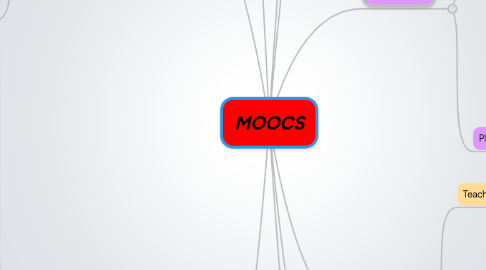
1. Issues
1.1. Autonomous Self Regulated Learners
1.2. Authentic Learning
1.3. Completeness of program
1.4. Accreditation
1.5. Scalability of assessment
1.6. Monetization - Revenue Model
1.6.1. On selling
1.6.2. Data Mining
1.6.3. Accreditation
1.6.4. Micropayment
1.6.4.1. “Once you have given away something it is very difficult then to make people pay for it.
1.6.5. Brand building
1.6.6. Corporate Sponsorship
1.6.7. Marketing
1.6.8. Feeder pathways
1.7. Pedagogy - Educational Model
1.7.1. Assessment
1.7.1.1. Crowd Sourced
1.7.1.2. Mechanical/Machine
1.8. Social Learning at Scale
1.8.1. Adaptation of Scale
1.9. Big Data
1.9.1. Education improvement
1.10. US-centricity
1.11. Drop out Rates
1.12. Quality of Online Courses
1.12.1. Quality of Content covered
1.12.2. Engagement of the Teacher
1.12.3. Interaction amongst Students
2. Curtin Strategy
2.1. Time Zone
2.1.1. Asia
2.1.2. Curtin Time
2.2. Market segment
2.2.1. UGrad
2.2.2. PGrad
2.2.3. Subject/Topic orientated
2.2.4. Continuing Professional Edcation
2.2.5. Pre UG - UniReady
2.3. Subject matter
2.3.1. Mining
2.3.2. Allied Health
2.3.3. UniReady
2.4. OER
2.5. Consortium
2.5.1. OUA
2.5.2. ATN
2.5.3. Asian
2.5.4. Canvas
3. Providers
3.1. For Profit
3.1.1. Udacity
3.1.2. Udemy
3.1.3. Marginal Revolution University
3.1.4. Coursera
3.1.4.1. Berklee College of Music
3.1.4.2. Brown University
3.1.4.3. California Institute of Technology
3.1.4.4. Columbia University
3.1.4.5. Duke University
3.1.4.6. École Polytechnique Fédérale de Lausanne
3.1.4.7. Emory University
3.1.4.8. Georgia Institute of Technology
3.1.4.9. Hebrew University of Jerusalem
3.1.4.10. Johns Hopkins University
3.1.4.11. Mount Sinai School of Medicine
3.1.4.12. Ohio State University
3.1.4.13. Princeton University
3.1.4.14. Rice University
3.1.4.15. Stanford University
3.1.4.16. The University of British Columbia
3.1.4.17. University of California, Irvine
3.1.4.18. University of California, San Francisco
3.1.4.19. University of Edinburgh
3.1.4.20. University of Florida
3.1.4.21. University of Illinois at Urbana-Champaign
3.1.4.22. University of London International Programmes
3.1.4.23. University of Maryland, College Park
3.1.4.24. University of Melbourne
3.1.4.25. University of Michigan
3.1.4.26. University of Pennsylvania
3.1.4.27. University of Pittsburgh
3.1.4.28. University of Toronto
3.1.4.29. University of Virginia
3.1.4.30. University of Washington
3.1.4.31. Vanderbilt University
3.1.4.32. Wesleyan University
3.1.4.33. The Hong Kong University of Science and Technology
3.1.5. Open Learning Initative
3.1.6. University of Pheonix
3.2. Non Profit
3.2.1. Edx
3.2.1.1. Harvard
3.2.1.2. MIT
3.2.1.3. Berkeley
3.2.2. Khan Academy
3.2.3. TED-ed
3.2.4. iTunesU
3.2.5. Canvas Network
3.2.6. The Open Univerity
3.2.7. UMass Opencourse
3.2.8. Alison
4. Pioneers
4.1. Stephen Downes and George Siemens
4.2. Dave Cormier
4.3. David Wiley
4.4. Jim Groom
4.5. Alec Couros
5. Definition
5.1. Course
5.1.1. Type
5.1.1.1. xMOOC
5.1.1.1.1. Extension of traditional education
5.1.1.2. cMOOC
5.1.1.2.1. Connectivism
5.1.2. Approach
5.1.2.1. Task based
5.1.2.2. Knowledge-based
5.1.2.3. Network-based
5.2. Event
5.3. Participatory
5.4. Open
5.5. Distributed
5.6. Shared experience
6. Delivery
6.1. Instructional content
6.1.1. OER
6.1.1.1. MIT Open Courseware
6.1.1.2. MERLOT
6.1.1.3. Khan Academy
6.1.1.4. YouTube
6.1.1.5. Connexions
6.1.1.6. Tufts OpenCourseWare
6.1.2. Participant generated
6.1.3. Free non-open
6.1.4. Non-free available for purchase
6.1.5. Non-open only available to course participants
6.2. Platform
6.2.1. LMS/VLE only
6.2.1.1. Blackboard "Coursesites"
6.2.1.2. Instructure "Canvas Network"
6.2.1.3. Stanford "Class2GO"
6.2.1.4. Apple "iTunesU"
6.2.1.5. Google "Course Builder"
6.2.2. Open Web only
6.2.2.1. MediaWiki
6.2.2.2. Wordpress
6.2.2.3. gRSShopper
6.2.3. LMS/VLE + Open Web
7. Roles
7.1. Teacher Role
7.1.1. Co-participant
7.1.2. Course and Cirriclum designer
7.1.3. Lecturer on videos/webinars
7.1.4. Facilitator on forums/Twitter
7.1.5. Blogger/summerizer
7.2. Student Role
7.2.1. Watch instructional videos
7.2.2. Complete online self-scoring assignments
7.2.3. Blog
7.2.4. Compile portfolio
7.2.5. Give peer feedback
7.2.6. Engage with community
7.2.7. Establish personal learning network
8. Openess
8.1. Free to enrol
8.2. No prerequisites to enrol
8.3. Relying on Open Educational Resourses
8.4. Open outcomes without pre-set Cirriculum
8.5. Learning and student work using platforms
9. Massiveness
9.1. Size of Course
9.1.1. Massive
9.1.1.1. 10,000-100,000
9.1.1.2. 1,000-5,000
9.1.2. Large
9.1.2.1. 500-1000
9.1.2.2. 100-500
9.1.3. Relative
9.1.3.1. Any size larger than normal
9.2. Time
9.2.1. Overall Length
9.2.1.1. Longer than a typical semester
9.2.1.2. Semester length - (8-12 weeks)
9.2.1.3. One or two weeks
9.2.2. Student time commitment
9.2.2.1. Self-determined
9.2.2.2. Full-time course equivalent
9.2.2.3. Limited
